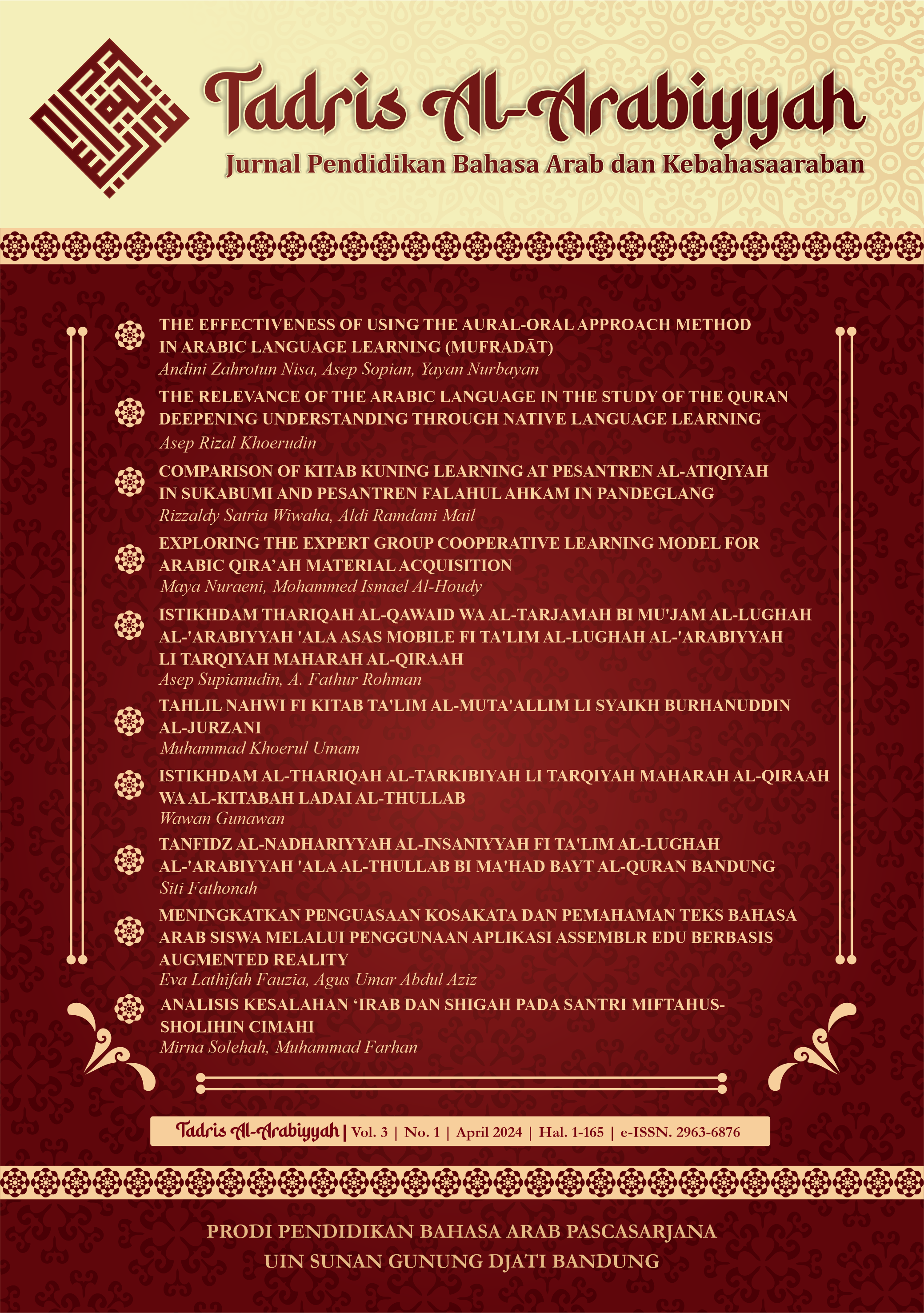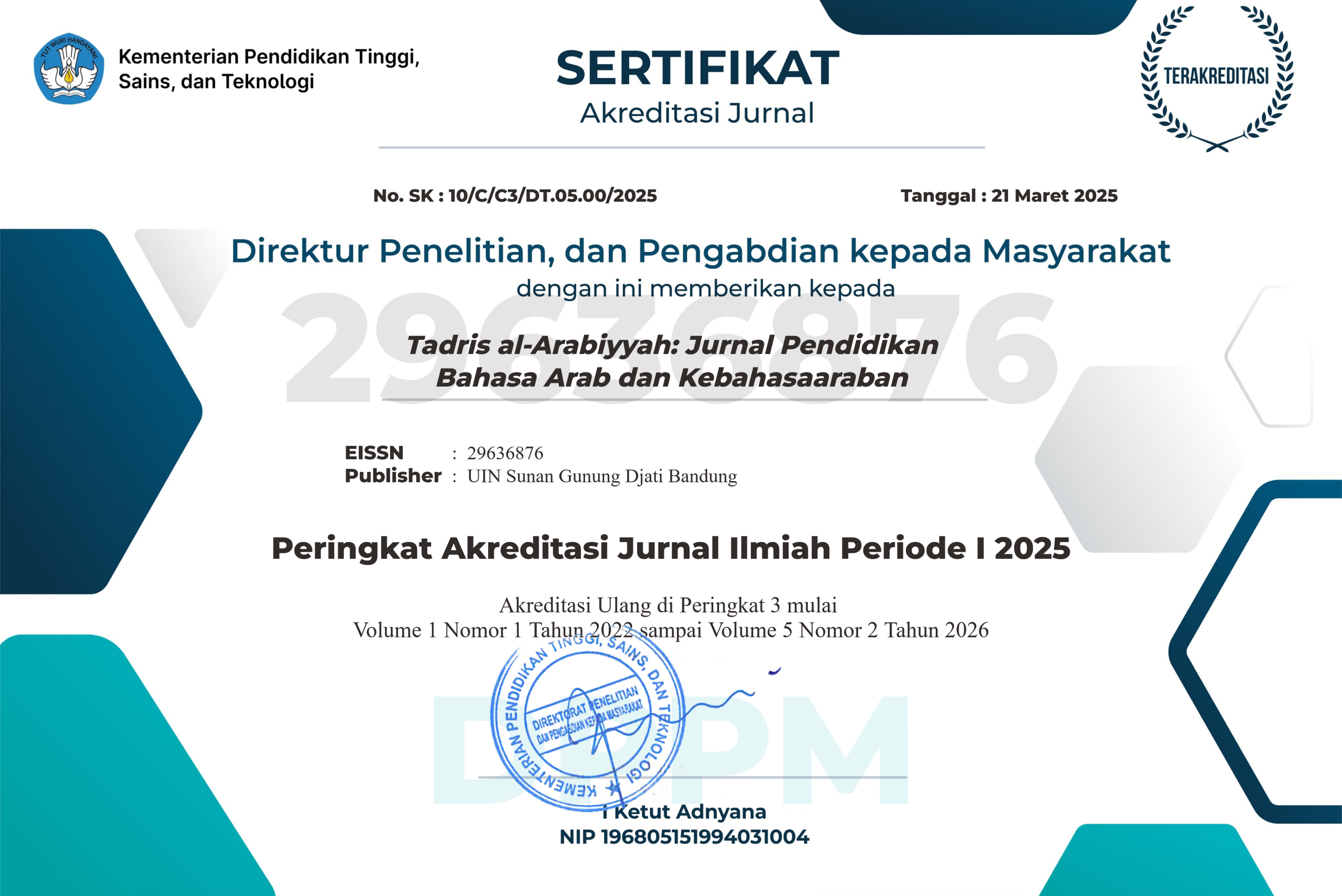The Importance of Arabic in Quran Study: Enhancing Understanding Through Native Language Learning
DOI:
https://doi.org/10.15575/ta.v3i1.34496Abstract
The Arabic language is essential for Muslims to understand the Quran deeply, which is necessary for Quranic studies. Learning Arabic allows access to the Quran's original meanings, enabling accurate interpretation beyond translation limitations. It provides insights into the historical and cultural context of the Quran's revelation, enriching reflection on divine messages. Additionally, studying Arabic sharpens linguistic skills and enhances comprehension of sacred teachings and spiritual meanings. In conclusion, mastering Arabic is crucial for a comprehensive understanding of the Quran, deepening spiritual connections, and effectively applying its teachings. This study explores the critical relevance of the Arabic language in the thorough research of the Quran, emphasizing how native language learning can deepen one's understanding of the sacred text. The study adopts a qualitative approach, involving detailed analyses of linguistic and interpretative aspects of Quranic Arabic alongside interviews with Quranic scholars and students. It investigates the intrinsic connection between the Arabic language and the meanings conveyed in the Quran, highlighting the nuances and depth often lost in translation. The study further examines how learning Arabic as a native language facilitates a more profound engagement with the text, enabling learners to grasp its subtleties, rhetorical devices, and cultural contexts. Findings suggest that native language learning enhances comprehension and enriches the spiritual and intellectual experience of studying the Quran. The research underscores the importance of integrating native language pedagogy in Quranic studies to foster a deeper, more authentic connection with the text. This study contributes to religious education by advocating for a more linguistically immersive approach to Quranic research, promoting a holistic understanding of its teachings.
References
Abdelaal, N. M., & Md Rashid, S. (2015). Semantic loss in the Holy Qur’an translation with special reference to Surah Al-Waqia (Chapter of The Event Inevitable). SAGE Open, 5(4), 2158244015605880. https://doi.org/10.1177/2158244015605880
Asy’ari, H. (2016). Keistimewaan Bahasa Arab Sebagai Bahasa Al-Qur’an. Nidhomul Haq: Jurnal Manajemen Pendidikan Islam, 1(1), 21–28. https://doi.org/10.31538/ndh.v1i1.5
Bustomi, B. (2020). Analisis Pendekatan Historis terhadap Diksi Istilah-istilah Perekonomian dalam Al-Qur’an. El-Afkar: Jurnal Pemikiran Keislaman Dan Tafsir Hadis, 9(2), 288–306. http://dx.doi.org/10.29300/jpkth.v9i2.3782
Chamidah, D., Sarif, A., & Maf’udah, S. (2023). Language differences in the Quran and their implications for Arabic teaching in Indonesia. Arabiyatuna: Jurnal Bahasa Arab, 7(2), 505–524. http://dx.doi.org/10.29240/jba.v7i2.8376
Dewi, I. S. (2016). Bahasa Arab dan Urgensinya dalam Memahami Al-Qur’an. Kontemplasi: Jurnal Ilmu-Ilmu Ushuluddin, 4(1), 39–50. https://doi.org/10.21274/kontem.2016.4.1.39-50
Fadillah, N., Azahra, B., Sapri, S., Daulay, F. A., Manjuntak, M. H., Adilla, N., Harahap, A. F., & Sabrina, T. (2024). Keistimewan Bahasa Arab Sebagai Bahasa Al-Qur’an. Atmosfer: Jurnal Pendidikan, Bahasa, Sastra, Seni, Budaya, Dan Sosial Humaniora, 2(1), 146–156. https://doi.org/10.59024/atmosfer.v2i1.664
Hadi, N. (2015). Kontribusi Al-Qur’an terhadap Perkembangan Bahasa Arab. El-Furqania : Jurnal Ushuluddin Dan Ilmu-Ilmu Keislaman, 1(1), 120–137. https://doi.org/10.54625/elfurqania.v1i01.883
Hanafri, M. I., Iqbal, M., & Santi, C. A. G. (2019). Aplikasi Pembelajaran Menghafal Surat-Surat Pilihan Al-Qur’an Untuk Sekolah Dasar Berbasis Android. Academic Journal of Computer Science Research, 1(1), 34–45. http://dx.doi.org/10.38101/ajcsr.v1i1.234
Hasan, M. A. K. (2023). Peran Bahasa Arab dalam Pendidikan Islam di Ma’had Aly Ar-Rasyid Wonogiri: Tinjauan Terhadap Pembelajaran Bahasa Arab sebagai Media Akses Ilmu Agama. Tatsqifiy: Jurnal Pendidikan Bahasa Arab, 4(2), 88–94. https://doi.org/10.30997/tjpba.v4i2.8642
Hasibuan, T. H., Huda, A. M., & Harianto, N. (2021). Meaning of Arabic Vocabulary (Description of Changes in Arabic Language Mufrodat Meaning). Attaqwa: Jurnal Ilmu Pendidikan Islam, 17(1), 96–107. https://doi.org/10.54069/attaqwa.v17i1.14
Hidayah, N., & Romlah, R. (2022). Kompetensi Guru Pendidikan Agama Islam (PAI) Menurut Undang-Undang No. 14 Tahun 2005 Relevansinya dengan QS al-Jumu’ah Ayat 2. Intiqad: Jurnal Agama Dan Pendidikan Islam, 14(2), 218–239. https://doi.org/10.30596/10460
Islam, M. H. (2019). Aplikasi dan Diferensiasi Pendidikan Islam. HUMANISTIKA: Jurnal Keislaman, 5(1), 73–95. https://doi.org/10.36835/humanistika.v5i1.149
Kamal, M. (2024). Imperatif Bahasa Arab pada Al-Qur’an. MARAS: Jurnal Penelitian Multidisiplin, 2(1), 528–536. https://doi.org/10.60126/maras.v2i1.215
Karim, A., Abubakar, A., & Kasim, A. (2018). Korelasi Antara Kemampuan Bahasa Arab dengan Pemahaman Ayat-Ayat Al-Qur’an terhadap Siswa Kelas XII Madrsahaliyah Al-Amanah Kota Baubau. Jurnal Diskursus Islam, 6(3), 459–480. https://doi.org/10.24252/jdi.v6i3.6546
Lintang, D. (2018). Pesona Style bahasa Arab sebagai Bahasa al-Qur’an dan Awal Mula Perkembangan Ilmu BalÄghah. Al Ashriyyah, 4(2), 22–22. https://doi.org/10.53038/alashriyyah.v4i2.37
Mahdali, F. (2020). Analisis Kemampuan Membaca Al-Qur’an dalam Perspektif Sosiologi Pengetahuan. Mashdar: Jurnal Studi Al-Qur’an Dan Hadis, 2(2), 143–168. https://doi.org/10.15548/mashdar.v2i2.1664
Manoppo, N., Laubaha, S. A., & Basarata, N. (2022). Ragam Aplikasi dalam Pembelajaran Bahasa Arab. Assuthur: Jurnal Pendidikan Bahasa Arab, 1(2), 80–97. https://doi.org/10.58194/as.v1i2.473
Mitrajati, K., Zaini, H., & Holilulloh, A. (2023). Acquisition of Arabic Vocabulary Through the Book Al-‘Arabiyyah Baina Yadaik (I) in Foreign Language Course Institutions. Scaffolding: Jurnal Pendidikan Islam Dan Multikulturalisme, 5(2), 1001–1014. https://doi.org/10.37680/scaffolding.v5i2.3407
Mohamed, Y., Ibrahim, M., Wan Ahmad, W. A., & Hajib, Z. A. (2018). Bahasa Arab Untuk Pengajian Islam: Keperluan Dan Autentik. Al-Abqari: Journal of Islamic Social Sciences and Humanities, 15(1), 93–106. https://doi.org/10.33102/abqari.vol15no1.31
Munir, M. S., Amrullah, A. M. K., Murni, W., Sulaikho, S., & Anwar, M. S. (2023). Evaluasi Kurikulum Pembelajaran Bahasa Arab di STIT Al Muslihuun Tlogo Blitar. Borneo Journal of Language and Education, 3(1), 67–86. https://doi.org/10.21093/benjole.v3i1.6440
Musthofa, Q. B. (2020). MawÄrid ‘AsÄ FÄ« Al QurÄn Al-KarÄ«m. Ta’lim al-’Arabiyyah: Jurnal Pendidikan Bahasa Arab & Kebahasaaraban, 4(1), 41–60. https://doi.org/10.15575/jpba.v4i1.8327
Nasution, N. S., & Lubis, L. (2023). Urgensi Pembelajaran Bahasa Arab dalam Pendidikan Islam. Jurnal Simki Pedagogia, 6(1), 181–191. https://doi.org/10.29407/jsp.v6i1.227
Olimat, S. N. (2018). Developing a Model for Translating Euphemism in the Qur’an: An Intratextual- and Contextual-based Approach. Advances in Language and Literary Studies, 9(6), 101–111. https://doi.org/10.7575/aiac.alls.v.9n.6p.101
Osman, R. A. H., & Hassan, M. I. A. (2022). Keistimewaan Bahasa Arab Sebagai bahasa al-Quran dan Kepentingan Menguasainya Bagi Para Mufassirīn: The Privilege of Arabic as the Language of the Qur’an and the Importance of Mastering It for the Mufassirīn. Al-Hikmah: International Journal of Islamic Studies and Human Sciences, 5(2), 325–342. https://doi.org/10.46722/hikmah.v5i2.260
Ramdane, T., & Souad, M. (2017). Towards a New Approach in the Teaching of the Holy Qur’an. International Journal of Humanities and Social Science, 7(10), 143–152. Retrieved from http://www.ijhssnet.com/journal/index/3964
Rashed, H. (2015). Towards a Common Ground: Arab Versus Western Views About Challenges of Islamic Religious Education Curriculum of the Twenty-First Century. Compare: A Journal of Comparative and International Education, 45(6), 953–977. https://doi.org/10.1080/03057925.2014.932247
Ridho, U. (2018). Evaluasi Dalam Pembelajaran Bahasa Arab. An Nabighoh Jurnal Pendidikan Dan Pembelajaran Bahasa Arab, 20(01), 19–26. https://doi.org/10.32332/an-nabighoh.v20i01.1124
Rohman, M. (2023). Efektifitas Pemberdayaan Al-Qur’an Dalam Metode Qiro’ah Sab’ah. Sinda: Comprehensive Journal of Islamic Social Studies, 3(1), 61–70. https://doi.org/10.28926/sinda.v3i1.1033
Ruslan, R., & Musbaing, M. (2023). Pembelajaran Bahasa Arab dengan Pendekatan Tafsir Al-Qur’an. Didaktika: Jurnal Kependidikan, 12(3), 215–230. https://doi.org/10.58230/27454312.218
Salida, A., & Zulpina, Z. (2023). Keistimewaan Bahasa Arab sebagai Bahasa Al-Quran dan Ijtihadiyyah. Jurnal Sathar, 1(1), 23–33. https://doi.org/10.59548/js.v1i1.40
Selim, N. (2018). Arabic, Grammar and Teaching: An Islamic Historical Perspective. International Journal of Islamic Thought, 13(1), 80–89. https://doi.org/10.24035/ijit.13.2018.008
Selviana, Y. (2021). Analisis Kesalahan Berbahasa Arab. Aphorisme: Journal of Arabic Language, Literature, and Education, 2(1), 68–91. https://doi.org/10.37680/aphorisme.v2i1.671
Sya’bani, M. Z., & Has, Q. A. B. (2023). Relevansi Bahasa Arab dalam Dakwah: Refleksi atas Kedudukan Bahasa Arab sebagai Bahasa Al-Quran (Tinjauan Literatur). Ath-Thariq: Jurnal Dakwah Dan Komunikasi, 7(1), 97–111. https://doi.org/10.32332/ath-thariq.v7i1.6532
Sya’diah, M., & Anshari, M. R. (2024). Motivating Children to Learn the Arabic Language Through Classic Arabic Books. Journal of Arabic Language Learning and Teaching (JALLT), 2(2), 71–88. https://doi.org/10.23971/jallt.v2i2.175
Tausiah, H., Rosita, E., Amanillah, S., & Sauri, S. (2019). Analysis Of Compiling Textbooks For Developing Reading Skills In Arabic Language. Jurnal Educational Technology: EDUTECH, 18(3), 340–347. https://doi.org/10.17509/e.v18i3.17501
Umam, M. K., & Syamsiyah, D. (2020). Konsep Pendidikan Humanistik Ki Hadjar Dewantara dan Relevansinya Terhadap Desain Pembelajaran Bahasa Arab. EDULAB: Majalah Ilmiah Laboratorium Pendidikan, 4(2), 59–82. https://doi.org/10.14421/edulab.2019.42-04
Zaen, A. A., Wahyudi, A., & Putra, M. F. S. (2023). Bahasa Arab Bahasa yang Tepat Sebagai Bahasa Al-Quran. Prosiding Konferensi Nasional Bahasa Arab, 9, 46–53. Retrieved from http://prosiding.arab-um.com/index.php/konasbara/article/view/1320









